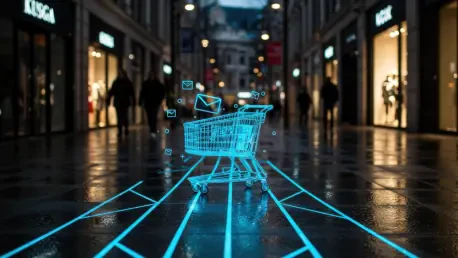The Retail Landscape: A Clash of Online and Offline Worlds
In today’s retail industry, a staggering 80-85% of global transactions still unfold within the walls of physical stores, despite the meteoric rise of e-commerce over recent years. This statistic underscores a persistent reality: while online platforms have transformed how consumers shop, the tactile experience of brick-and-mortar retail remains a cornerstone of commerce. The tension between these two worlds shapes the current market, as businesses grapple with balancing digital convenience against the enduring appeal of in-person shopping.
Key players like Amazon dominate the e-commerce sphere, leveraging vast technological resources to redefine consumer expectations. Meanwhile, traditional retailers such as Aldi continue to expand their physical footprints, capitalizing on local presence and customer loyalty. Both channels hold significant sway in the market, with online retail offering unmatched accessibility and physical stores providing sensory engagement and immediacy that digital cannot replicate.
Technology, particularly artificial intelligence (AI), plays a pivotal role in this evolving dynamic. AI is reshaping retail by optimizing supply chains, personalizing customer interactions, and predicting trends with unprecedented accuracy. Yet, as consumer expectations shift toward seamless integration of online and offline experiences, the industry faces the challenge of harnessing such innovations without losing the human connection that physical retail fosters.
Amazon’s Vision: AI as the Future of Retail Dominance
AI-Driven E-Commerce Innovations
Amazon stands at the forefront of AI-driven transformation in retail, deploying cutting-edge tools to enhance its online dominance. From smart glasses designed to streamline delivery operations for drivers to algorithms that tailor shopping experiences for individual consumers, the company’s technological arsenal is vast. These innovations aim to make online shopping not just convenient but intuitively personalized, setting a high bar for competitors.
Under CEO Andy Jassy’s leadership, there is a bold assertion that online retail will eventually eclipse physical stores, propelled by AI’s ability to revolutionize inventory management and consumer insights. This vision is backed by substantial financial commitment, with investments in AI projected to exceed $100 billion over the current and upcoming years. Such figures highlight a strategy deeply rooted in technology as the key to market leadership.
The focus on AI is not merely about efficiency but about redefining how consumers interact with retail platforms. By leveraging data to anticipate needs and streamline operations, Amazon seeks to solidify its position as the go-to destination for online shoppers, betting heavily on a future where digital transactions dominate the retail landscape.
Market Trends and Projections
E-commerce continues to grow at a rapid pace, with Amazon leading the charge as a dominant force in this space. Industry data indicates that online sales are expanding year over year, capturing an increasing share of consumer spending. This growth trajectory aligns with forecasts suggesting a gradual shift away from traditional retail, though the pace and extent of this transition remain subjects of debate.
Despite these projections, a notable resurgence of interest in physical stores has emerged in the post-COVID era. Consumers are returning to high streets and malls, drawn by the social and experiential elements of in-person shopping. This trend challenges the narrative of inevitable online dominance, revealing a more complex picture where both channels vie for relevance in a fragmented market.
AI’s impact on retail efficiency offers tangible performance indicators, particularly in Amazon’s online operations. Enhanced logistics, reduced delivery times, and improved customer satisfaction metrics all point to technology’s transformative potential. However, whether these digital gains can fully offset the cultural and communal value of physical retail remains an open question for the industry.
Amazon’s Struggles in Physical Retail: A Strategic Misstep
Amazon’s foray into physical retail has been marked by high-profile setbacks, casting doubt on its ability to master this domain. The $13.7 billion acquisition of Whole Foods aimed to establish a foothold in grocery retail but has struggled to yield the expected synergies. Similarly, the closure of 19 Amazon Fresh stores in the UK, with only a handful repurposed, signals a retreat from ambitious expansion plans.
Industry experts have pointed to a fundamental flaw in Amazon’s approach, arguing that the company lacks a deep understanding of physical retail dynamics. Ged Futter, a seasoned retail consultant, critiques the tech giant for relying on vast resources and algorithms without grasping the nuanced customer interactions that define in-store success. This gap has hindered Amazon’s ability to compete with traditional players who prioritize localized engagement.
In stark contrast, retailers like Aldi have thrived by expanding their physical presence, opening over 100 stores in a timeframe where Amazon scaled back. This disparity underscores a strategic misstep for the e-commerce leader, suggesting that success in physical retail requires more than financial might. Adapting to local market conditions and fostering genuine customer connections in-store could offer a path forward, though such shifts demand a departure from Amazon’s tech-centric playbook.
Regulatory and Operational Challenges in Retail Innovation
Navigating the regulatory landscape presents significant hurdles for retail innovators like Amazon, particularly as AI-driven personalization raises data privacy concerns. Governments worldwide are tightening rules around consumer data usage, requiring companies to balance technological advancements with stringent compliance. These regulations impact both online platforms and physical operations, creating a complex environment for tech giants entering traditional spaces.
Compliance is not the only challenge; operational integration of AI into physical stores poses its own difficulties. While technology can enhance inventory tracking or customer service, it risks alienating shoppers if it feels impersonal or intrusive. Maintaining the community appeal of physical retail while deploying advanced systems demands a delicate equilibrium, one that Amazon and others are still working to achieve.
Looking ahead, regulatory changes could further complicate AI implementation in retail, forcing companies to prioritize consumer protection alongside innovation. Striking this balance will be critical, as failure to do so may erode trust and limit the adoption of new tools. For industry players, the challenge lies in evolving operational models to align with both legal mandates and customer expectations.
The Future of Retail: A Hybrid Model of Physical and Digital
Emerging trends point toward a retail future where AI enhances not just online platforms but also in-store experiences. From interactive displays to personalized recommendations at the point of sale, technology holds the potential to make physical shopping more engaging. This dual application suggests a landscape where digital and physical retail are not rivals but complementary forces.
Physical stores retain enduring value as community hubs, offering social interaction and a sense of belonging that e-commerce struggles to match. High streets and local shops serve as more than transactional spaces; they are venues for connection, a role that remains vital amid growing digital fatigue. This cultural significance ensures that brick-and-mortar retail will continue to hold a prominent place in consumer behavior.
Disruptors such as shifting consumer preferences for convenience and connection will shape retail’s trajectory, alongside global economic conditions and technological innovation. A hybrid model, blending the strengths of online efficiency with the tangible appeal of physical spaces, appears increasingly likely. For companies navigating this future, the ability to adapt to these multifaceted demands will determine long-term success.
Conclusion: Balancing AI Innovation with Physical Retail Realities
Reflecting on the analysis, Amazon’s ambitious drive to leverage AI has reshaped e-commerce, setting new benchmarks for efficiency and personalization. Yet, the company’s ventures into physical retail have stumbled, revealing a disconnect from the intricate dynamics of in-store shopping. These struggles have highlighted a broader truth: the resilience and cultural importance of brick-and-mortar stores endure, even as digital platforms gain ground.
Looking ahead, a balanced approach emerges as the most viable path. Industry players, including Amazon, need to deepen their understanding of physical retail’s unique demands, integrating technology not as a replacement but as an enhancement to the in-store experience. By prioritizing strategies that support a hybrid ecosystem—where online and offline channels reinforce each other—retailers can better meet evolving consumer needs. This focus on synergy, rather than dominance of one model over another, promises to guide the industry toward sustainable growth and innovation.









